by Joshua Thomas
Police scanners are indispensable when it comes to getting up to the minute information and news related to emergency services like the weather, air traffic control, road condition updates, and many community activities.
A police scanner keeps you informed with important information from around you, most of which you may never know without a scanner. In fact, if you're considering whether you need a police scanner or not, then the probable answer is: Yes.
Modern police scanners are complex devices with lots of features that need understanding. This best police scanners review offers you this information so that you can make the right choice and buy the most ideal scanner.
| IMAGE | PRODUCT | FEATURES |
|---|---|---|
 | 1. Uniden BCD536HP (Best Overall) |
|
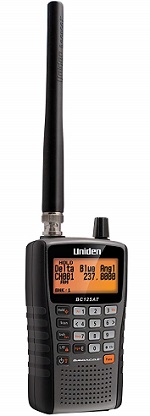 | 2. Uniden Bearcat BC125AT |
|
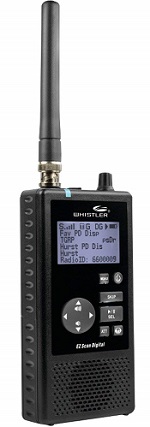 | 3. Whistler WS1080 |
|
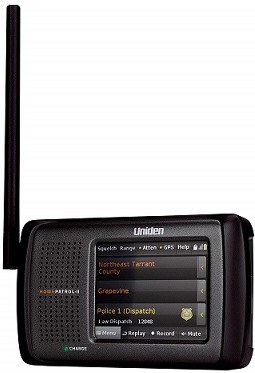 | 4. Uniden HomePatrol-2 |
|
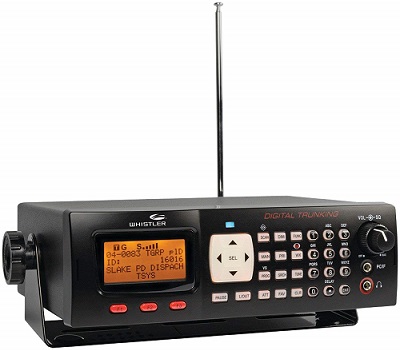 | 5. Whistler WS1065 |
|
6. Uniden BCT15X |
| |
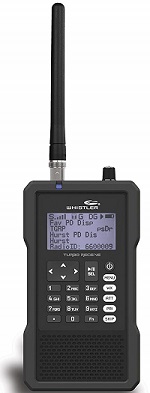 | 7. Whistler TRX-1 |
|
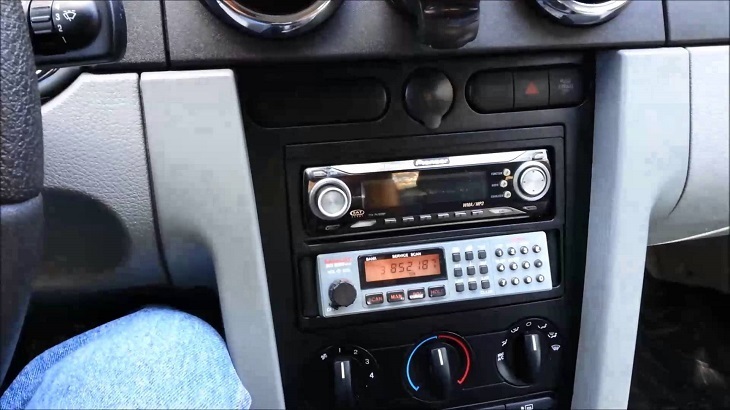

If you can afford it, then why not get this best digital police scanner from Uniden? It picks up everything out there and is very easy to use once you figure it out.
It offers a microSD slot with 4GB of storage, which is enough to hold the entire radio systems of both the United States and Canada. It even has some remaining space for hundreds of hours of recordings.
You get it with the TrunkTracker V system, which supports so many formats including APCO 25 Phases I and II, EDACS, Motorola, X2-TDMA, and LTR trunked systems.
You also get a large dot-matrix display with a backlight, a keypad, WiFi NOAA weather alerts with S.A.M.E., USB connectivity to your computer, and a very intuitive and easy to use scanning system.
Two problems with this scanner is its high price and the lots of things that you'll need to learn, else it's a great device.
Also, installing a mobile police scanner in a car requires a license in some states, so make sure you check your local laws first if you intend mounting this tracker in your car.
Pros
Cons

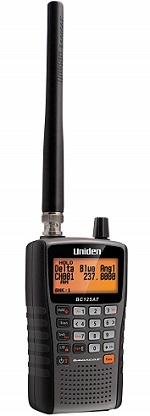
Uniden makes great scanners, so for the best handheld police scanner, we'll also take a look at a Uniden device. It comes with a brightly lit LCD screen and offers 500 channels with alpha-tagging. This allows you to easily name the channels as you wish.
It covers frequencies from 25 MHz to 512 MHz and you can set the modulations to either FM, AM, NFM, or Auto. There are 10 banks with 50 channels each per bank, giving you the 500 total.
Programming it is easy although time-consuming, but you can download Uniden's software if you want and then program it using your computer.
You should note that this scanner has been around for some time and that Uniden has a newer version of it, but the newer version only has a 300-channel memory.
Still, the package includes a USB cable and the scanner features an auto service search feature.
Pros
Cons

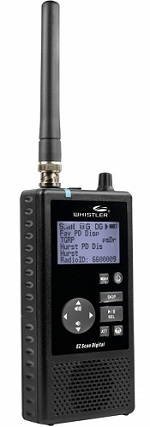
The Whistler WS1080 is Whistler's top of the line handheld digital scanner with plenty of impressive features. It comes with a 2 GB memory card with a list of all the entire United States radio systems and frequencies.
Its frequency coverage includes everything from 25 MHz up to 1,300 MHz and it's a Phase II digital scanner, which means it picks up all kinds of formats including trunking signals, X2-TDMA, Motorola, and many more that make it one of the best portable police scanners in the market.
Another great feature it comes with is scan-lists. It features 200 scan-lists, which allows you to group your objects into any of the lists and to as many lists as possible.
You get an audio-recording feature, LED and audible alerts, pre-defined service searches, clock, calendar, and a full USB interface. The package also includes a PC software to easily customize your programming and keep things updated.
For the cons, you've got the high price and its use of AA batteries in place of a rechargeable Lithium-ion battery, for instance.
Further interesting features include a signal strength meter, S.A.M.E and bad weather alerting, plus a powerful spectrum sweeper to round it all off.
Pros
Cons


Uniden presents the HomePatrol-2 here. It's not just a top-rated police scanner but a full-fledged system that's additionally very easy to control. In fact, it even comes with a touchscreen, and that's in full color!
Compared to the HomePatrol-1, this one includes TDMA Phase II ability, making it able to deliver all the signals in your given area. Setup is fast and needs you to only enter your Zip code, then you're good to go.
Its reception is great and combines well with the detailed display information. You also get a flex antenna and a desk-stand as part of the package.
Further impressive features that make it one of the best police scanners include rechargeable batteries, USB cable, a record and replay function, easy favorite list creation, and channel descriptions that give more details than most other devices you've seen.
Uniden backs it with a 1-year warranty and offers a programming software as well to help customize it better. The best part of this scanner remains its colorful display and easy to navigate touchscreen.
Pros
Cons

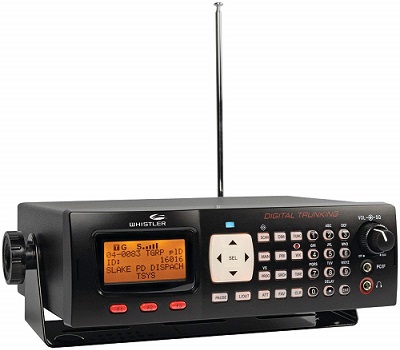
Here comes another good police scanner from Whistler. This one is a desktop type and includes all the traditional features that you'll find in any good scanner.
It's digital but it can only handle APCO-25 Phase I signals and since it has no Phase II hardware, even a firmware upgrade won't make it handle Phase II signals. Its 1,800 channels is also comparably limited.
On the brighter side though, this scanner offers lots of impressive features like LED and audible alerts, data cloning to other devices, automatic low audio level compensation, and a key lock function to avoid tampering.
Further features include a fast spectrum sweeper, a scan list function, which allows you to arrange and group the scan objects as you please, plus the ability to back up and update records on a computer.
Pros
Cons


This Uniden BCT15X is an analog base/mobile scanner that is great both on the road and as a base station. It features 9,000 channels plus other impressive features like its dynamic memory system and close call RF capture.
It also offers GPS based tracking, a feature that automatically scans for stations based on your GPS location. You'll need an extra GPS antenna for this though and it's not included in the package.
The package does include an AC adapter and cigarette lighter adapter, making it easier for you to use it anywhere. There is also a mounting bracket and hardware, plus a telescopic antenna with BNC.
Being analog means that this tracker won't pick up any digital formats, but it works very well with the analog ones, including trunked systems like LTR, Motorola, and EDACS.
Other important features that make it one of the best mobile police scanners include channel tagging, band scope, weather alerts, priority ID on trunked systems, and up to 500 search lockouts.
Pros
Cons

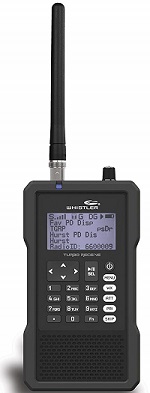
The Whistler TRX-1 is a portable police scanner with all the features that you can wish for in a portable scanner. It uses scan lists and can manage up to 200 different lists, but there is no limit to how many channels a list can contain.
In addition to being able to manage millions of channels, it scans the entire frequency range from 25 MHz to 1,300 MHz and can handle both analog and digital formats, including Phase I and II formats.
It can handle trunking systems as well, including Motorola, EDACS, and LTR. The package includes a microSD card, swivel belt clip, antenna, USB cable, and helpful guides.
The 2 GB card can hold up to 50 hours of audio recordings and they include date and timestamps. You also get a nice display, easy to use keys, alarm, and auto wake-and-scan feature, which lets you set a time for the scanner to wake up and start scanning.
The included USB cable makes connecting to a computer and the Internet easy, although you already got enough information on the included microSD card. If you do need more space anyway, then the TRX-1 supports up to 32-GB cards.
Pros
Cons

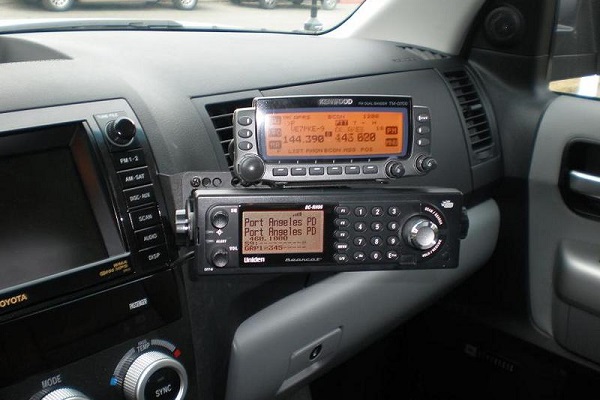
Police scanners have evolved over the years, making it difficult for most people to know the right device to choose.
If you've gone through the list above and find that you need a little help understanding some of the terms, the following buying guide will help you out and give you all the information you need to buy the best police scanner that meets your needs.
The first major difference between police scanners is the build type, which means its physical dimensions and intended use. There are three major types of police scanners and they are as follows:
Handheld
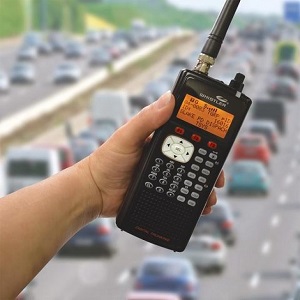
This is the smallest and most portable type of police scanner available. It's designed to get carried around easily, making it as light and hand-portable as possible.
Handheld scanners pay the price for their portability, including less sound volume, poorer receptions, and more prone to damage. On the positive side, they're usually battery-powered and so they're not susceptible to power outages.
Desktop
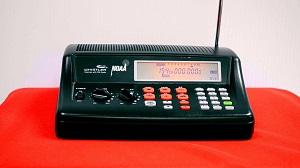
Photo: Whistler
A desktop police scanner is as its name suggests, designed for installation on a desktop. This means that it stays fixed to a single place and usually depends on a wall outlet for power.
Desktop police scanners usually have the best reception, sound volume, and range than the other police scanner types but they do have their disadvantages as well. These include a lack of portability and a susceptibility to power outages.
Mobile
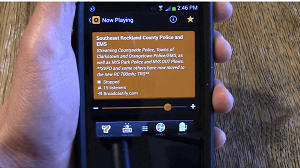
This third type of police scanners lies somewhere between the other two. They are larger than handheld scanners but they are mobile and are usually mounted on car dashboards.
Mobile scanners have a better reception and range than handheld scanners and they're often made better using external antennas. They can also run on household power or on a car's power supply, depending on available accessories.
The sound from a police scanner gets encoded using different technologies to make it wirelessly transmittable over distances. These formats have gotten better over the news and additionally increased in number as a result.
Where you live or what you want to listen to will help in determining the type of format that you need, but it's worth noting that everything is going digital and that scanners with the newer formats can always receive the older formats.
Following is a look at these formats:
Analog. This is the oldest police scanner signal format and it's simply plain old radio waves that get modulated with whatever information is being broadcast on a particular frequency.
Trunked. Trunked formats came about to de-clutter certain overused frequencies and to evenly spread out groups or organizations over a frequency effectively.
These systems are popular in urban or congested areas and they work by providing an identification for each group, which allows only members of that group to listen in on the group's communications.
Digital. A digital scanner is able to encode or decode digital information over the airwaves. The digitally encoded information offers lots of advantages over analog signals like better clarity and range.
These advantages make digital scanners continue to gain in popularity, although they're costlier than analog systems. More and more agencies are also shifting to digital scanners since they are more future proof.
There are two digital formats, the APCO-25 Phase I and the Phase II formats, with the latter being the most preferred and recommended format. Digital scanners can also pick up analog and trunked radio services while Phase II scanners can pick up everything.
Some scanners will offer you 30 to 50 channels while others will offer you a thousand channels or more. Your choice here depends entirely on what you intend to do or listen to.
There are so many frequencies available and the job of a scanner is to go through them. Scanners can receive this wide range of communications and they can range anywhere from 25 MHz to over 800 MHz.
Many frequency ranges like 25 to 50 MHz got mapped out and called bands, while the frequencies in a band get divided into channels every 5 kHz (or larger channel) of the way. These are the channels that a scanner scans through, looking for a signal.
This feature applies mostly to older police scanners because newer devices have so much processing power that it doesn't matter anymore. A scanner's scan rate refers to how many channels it can scan in a second, so pay attention to it if you're after an old device.
Sensitivity is a measure of how precise the scanner is in isolating a signal. It's measured in microvolts, with a lower value meaning a higher sensitivity. You want your scanner's sensitivity as high as possible.
Uniden BC365CRS 500 Channel Scanner and Alarm Clock with Snooze, Sleep, and FM Radio with - Walmart Link
Uniden BEARTRACKER 885 Hybrid Full-Featured CB Radio + Digital TrunkTracking - Walmart Link
Uniden HomePatrol-2 Color Touchscreen Simple Program Digital Scanner, TrunkTracker V and - Walmart Link
Uniden BCD996P2 Digital Mobile TrunkTracker V Scanner, 25,000 Dynamically Allocated - Walmart Link
Uniden BC75XLT, 300-Channel Handheld Scanner, Emergency, Marine, Auto Racing, CB Radio, - Walmart Link
Uniden BCD536HP HomePatrol Series Digital Phase 2 Base/Mobile Scanner with HPDB and - Walmart Link
Uniden Bearcat BC125AT Handheld Scanner, 500-Alpha-Tagged Channels, Close Call - Walmart Link
Uniden BC365CRS 500 Channel Scanner and Alarm Clock with Snooze, Sleep, and FM Radio with - eBay Link
Uniden BEARTRACKER 885 Hybrid Full-Featured CB Radio + Digital TrunkTracking - eBay Link
Uniden HomePatrol-2 Color Touchscreen Simple Program Digital Scanner, TrunkTracker V and - eBay Link
Uniden BCD996P2 Digital Mobile TrunkTracker V Scanner, 25,000 Dynamically Allocated - eBay Link
Uniden BC75XLT, 300-Channel Handheld Scanner, Emergency, Marine, Auto Racing, CB Radio, - eBay Link
Uniden BCD536HP HomePatrol Series Digital Phase 2 Base/Mobile Scanner with HPDB and - eBay Link
Uniden Bearcat BC125AT Handheld Scanner, 500-Alpha-Tagged Channels, Close Call - eBay Link

We've come to the end of this best police scanners review and you've seen the best offers out there, both handheld and base/mobile stations, as well as analog and digital ones.
There are also those that connect easily to the computer and allow you to program them faster than you could have done by hand.
The choice is, therefore, yours alone to make here based on your individual needs and your budget.
 |
 |
 |
 |

About Joshua Thomas
Joshua Thomas just simply loves cars and willing to work on them whenever there's chance... sometimes for free.
He started CarCareTotal back in 2017 from the advices of total strangers who witnessed his amazing skills in car repairs here and there.
His goal with this creation is to help car owners better learn how to maintain and repair their cars; as such, the site would cover alot of areas: troubleshooting, product recommendations, tips & tricks.
Joshua received Bachelor of Science in Mechanical Engineering at San Diego State University.